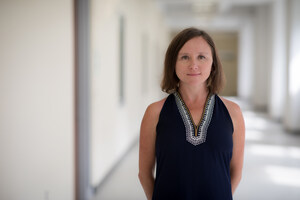BRONX, N.Y., Dec. 7, 2016 /PRNewswire-USNewswire/ -- Falls are the leading cause of fatal and non-fatal injuries among older Americans and all too often lead to physical decline and loss of independence. Now, researchers at Albert Einstein College of Medicine have found that measuring the brain activity of healthy older adults while they're walking and talking can predict their risk of falling. Their research is published today in the online issue of Neurology®, the medical journal of the American Academy of Neurology.
"Previous studies have shown that when older people perform cognitively demanding tasks, their brains are required to become more active to handle the challenge," says lead author Joe Verghese, M.B.B.S., director of the division of cognitive & motor aging at Einstein and Montefiore Health System (and director of the Montefiore Einstein Center for the Aging Brain. "In our study, we asked older people to perform such a task—in this case, talking while walking—and found that people needing the most brain activity to carry it out were more likely than others to fall later on."
According to the U.S. Centers for Disease Control and Prevention, one of every three adults aged 65 and over falls each year, leading to nearly 20,000 deaths. Even when falls don't cause injury, they may cause older people to develop a fear of falling that can limit their activities and reduce their mobility. Those who know they're at risk for falling can take simple measures—removing tripping hazards from their homes, for example—that can substantially reduce the risk of falls.
The study involved 166 older adults, average age 75, enrolled in the ongoing Central Control of Mobility in Aging Study at Einstein. All participants were healthy, with no signs of dementia, disability, or problems with walking. Researchers asked them to perform three different tasks: walking at a normal pace, reciting alternate letters of the alphabet while standing, and walking at a normal pace while simultaneously reciting alternating letters of the alphabet.
Dr. Verghese and his colleagues measured the participants' walking speed and "letter-reciting" speed. And during all three tasks, they assessed the participants' brain activity. This was done using functional near-infrared spectroscopy—a noninvasive brain-imaging technology in which participants wear sensors over their foreheads that measure changes in oxygen levels in the front of their brains. After the testing, researchers contacted participants every two to three months over the following four years to find out whether they had fallen. Seventy one study participants reported a total of 116 falls during that time, and 34 of those people fell more than once. (Most falls were not serious, with only five percent of them resulting in fractures.)
Neither the speed at which the subjects walked nor their speed of naming alphabet letters predicted which of them would be more likely to fall. The subjects' brain activity during just walking or just talking also did not correlate with their risk for falling. But when the researchers looked at brain activity when subjects were walking while talking, they found that elevated levels of brain activity during this task signaled an increased risk of falling in the future: each incremental increase in brain activity was associated with a 32 percent increased risk of falls. This relationship between increased brain activity and falling risk persisted even after researchers accounted for slow walking speed, frailty, previous falls and other factors that could affect a person's risk of falling.
"Our findings suggest that changes in brain activity that influence walking may be present long before people exhibit any sign of walking difficulty. Now we need to find the underlying biological mechanisms or diseases that may be altering brain activity and, if possible, correct them to help prevent falls," says Dr. Verghese, who also holds the Murray D. Gross Memorial Faculty Scholar in Gerontology at Einstein.
Other Einstein researchers involved in the study were Cuiling Wang, Ph.D., Emmeline Ayers, MPH, and Roee Holtzer, Ph.D.
About Albert Einstein College of Medicine
Albert Einstein College of Medicine is one of the nation's premier centers for research, medical education and clinical investigation. During the 2016-2017 academic year, Einstein is home to 717 M.D. students, 166 Ph.D. students, 103 students in the combined M.D./Ph.D. program, and 278 postdoctoral research fellows. The College of Medicine has more than 1,900 full-time faculty members located on the main campus and at its clinical affiliates. In 2016, Einstein received more than $160 million in awards from the National Institutes of Health (NIH). This includes the funding of major research centers at Einstein in aging, intellectual development disorders, diabetes, cancer, clinical and translational research, liver disease, and AIDS. Other areas where the College of Medicine is concentrating its efforts include developmental brain research, neuroscience, cardiac disease, and initiatives to reduce and eliminate ethnic and racial health disparities. Its partnership with Montefiore Medical Center, the University Hospital and academic medical center for Einstein, advances clinical and translational research to accelerate the pace at which new discoveries become the treatments and therapies that benefit patients. Einstein runs one of the largest residency and fellowship training programs in the medical and dental professions in the United States through Montefiore and an affiliation network involving hospitals and medical centers in the Bronx, Brooklyn and on Long Island. For more information, please visit www.einstein.yu.edu, read our blog, follow us on Twitter, like us on Facebook, and view us on YouTube.
Logo - http://photos.prnewswire.com/prnh/20120531/DC16559LOGO
SOURCE Albert Einstein College of Medicine
Related Links
WANT YOUR COMPANY'S NEWS FEATURED ON PRNEWSWIRE.COM?
Newsrooms &
Influencers
Digital Media
Outlets
Journalists
Opted In






Share this article